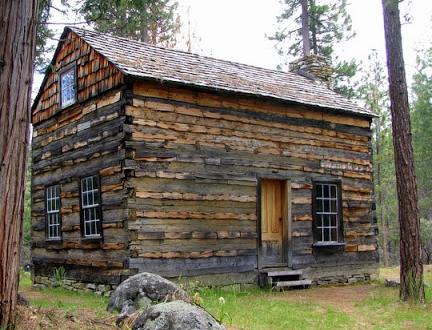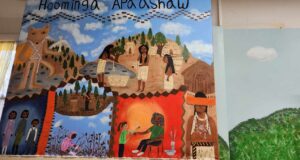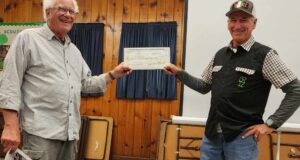If you haven’t purchased the book Exploring the Sierra Vista National Scenic Byway and spent a day or two or three on the tour that is literally in our back yard, then now is the time, before the snows come. The book is available for $15 at the Coarsegold Historic and Fresno Flats museums—close at hand.
You can start the tour in Fresno or at Road 200 and Hwy 41. Read the history as you travel; sometimes you will have to stop because there is so much to read about an area—Finegold, for instance, is no longer there but the book gives you a wealth of information about this booming gold town of the old days, 1850s to 1907.
But, this particular article is about a wonderful hand-hewn log cabin that was built by prospector Jesse Blakely Ross in the late 1860s. You will see it and enter it on your tour. At about 4,000 feet altitude, it is one of the oldest structures in Madera County. It stands about 14 miles from North Fork. The book gives specific instructions on how to get to the house from Forest Road 81.
“When Jesse built the cabin, he was a bachelor and he thought it was plenty big for his modest needs. A few years later, he met and married Mary Waspi, a local Mono Indian. In December of 1871, Mary gave birth to a little girl who they named Julia Belle Ross. Some years later the ground floor of the cabin was partitioned off and, for a short time, stairs went to the second floor.
“Ross planted a five-acre apple orchard near the cabin, originally built on a parcel of land about one-half mile on up the road. He also planted wheat and pink beans on the ranch, and harvested them for sale in Fresno. Jesse posthumously received a Homestead Patent from the U.S. Government in 1900, shortly after he had died and been buried near Ross Creek. The land passed through the hands of Julia, who died in 1904, and her husband George Hallock, before being purchased by Samuel L. Hogue in 1910.
“Hogue had been the first schoolteacher in Selma and also served as a Justice of the Peace in Fresno. He moved his family into the log house that Jesse Ross had built, and renamed it the ‘Hogue Ranch.’ He planted more apple trees and beans to satisfy the demand for the fruits and vegetables that helped to prevent ‘land scurvy.’ Just as sailors got sick, so scurvy weakened the early miners, timber jacks and cattlemen, and they fell prey to the elements and exposure.
“There was plenty of game and fish, but they needed fruit and vegetables to remain healthy. Hogue and his sons even built a small sawmill with a wooden waterwheel on Ross Creek in order to make apple boxes for shipping the fruit, and continued to raise pink beans as well as hogs until he sold his ranch in 1930.The Hogue Ranch has passed through several more owners since that time.”
In 1990, the cabin was given to the U.S. Forest Service by Richard and Jeanetta McClurg, with the provision that it be moved off the private property and preserved. The fireplace was dismantled stone by stone and rebuilt. A house moving company was able to jack up the cabin, place rubber-tired dollies underneath, and move it in one piece without damage.
The logs needing replacement were hand hewn using tools of the 1860s (and be sure to note the hand-made nails used). The walls were wallpapered with newspapers from 1893 to 1945. Truly, this is a treasure.
You are missing a wonderful experience if you don’t take the Scenic Byway tour—with the book that tells everything there is to know about everything you will see!





Thank you for this informative article. If possible, could you include a link to show the location on Google maps?